Guest post by Quentin Buvelot, Senior Curator, Mauritshuis, The Hague, Netherlands
In 2012, the Mauritshuis in The Hague managed to acquire a particularly appealing painting by Clara Peeters, Still Life with Cheeses, Almonds and Pretzels (Fig. 1).

The still life can be dated to circa 1615. The museum bought it from an American private collector who was willing to part with this well-preserved treasure. Recently CODART, the international network of curators of Dutch and Flemish art, has selected this still life to be among the 100 Dutch and Flemish works of art that make up the first CODART Canon of historically important works of art before 1750.
[The Peeters painting is of five artworks by women to be included in the CODART Canon. See also the Art Herstory guest post Floral Still Life, 1726—A Masterpiece by Rachel Ruysch, by Lawrence Nichols, curator at the Toledo Museum of Art.]
Ruysch, Van Oosterwyck, Leyster
Female painters may be very popular today, as is made clear by the CODART Canon. But their work was already appreciated in the nineteenth century, judging from earlier acquisitions made by the successive directors of the Mauritshuis. In 1826, only four years after the opening of the Royal Picture Gallery in the historic building known as the Mauritshuis, the museum purchased a wonderful flower still life dated 1700 by the celebrated Rachel Ruysch (1664–1750; Fig. 2).
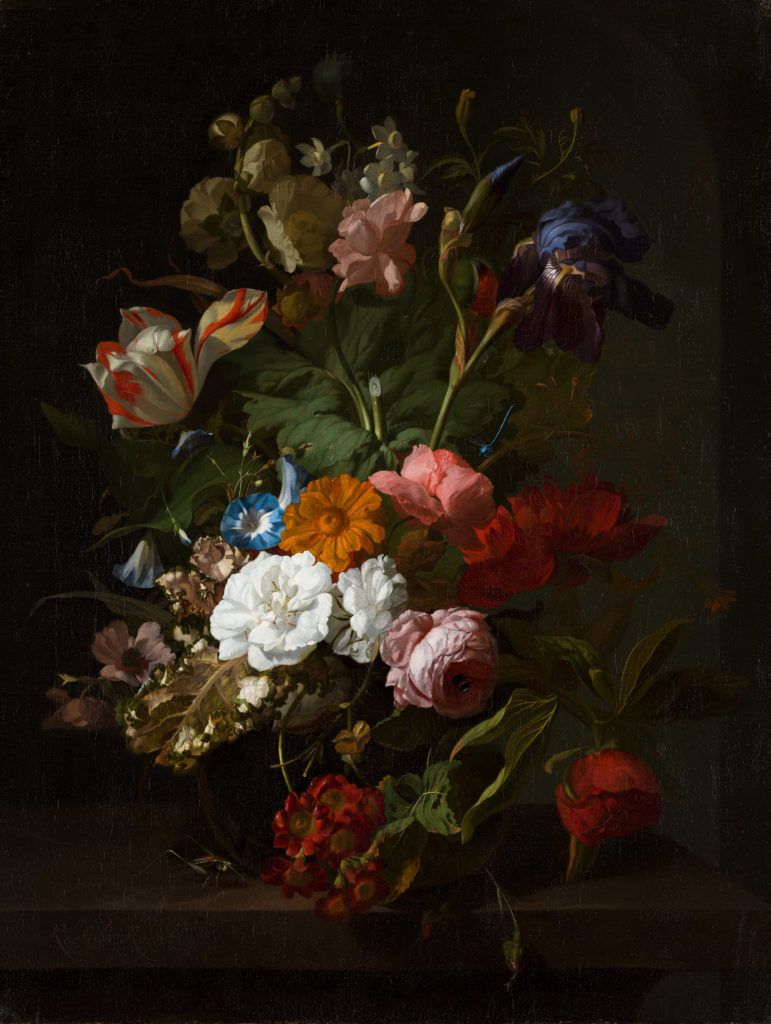
Fig. 2, Vase with Flowers, 1700, by Rachel Ruysch. Mauritshuis, The Hague.
Much later, in 1882, a painting of the same subject from the early 1670s by Maria van Oosterwyck (1630–1693) entered the collection (Fig. 3).
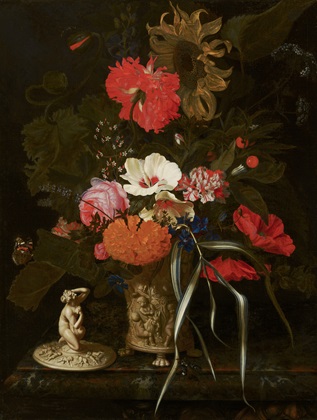
In the following decade, in 1892, the museum acquired a wonderful genre painting which at that time could not yet be securely attributed. Man Offering Money to a Young Woman (Fig. 4) was listed in the museum’s inventory as ‘Dutch school’, and the annual report of 1892 mentions the search for the name of the supposedly male painter. Soon after the acquisition, however, the date 1631 was discovered, as well as the monogram of the painter, Judith Leyster (1609–1660)—now a celebrated painter, but completely forgotten after her death in 1660.
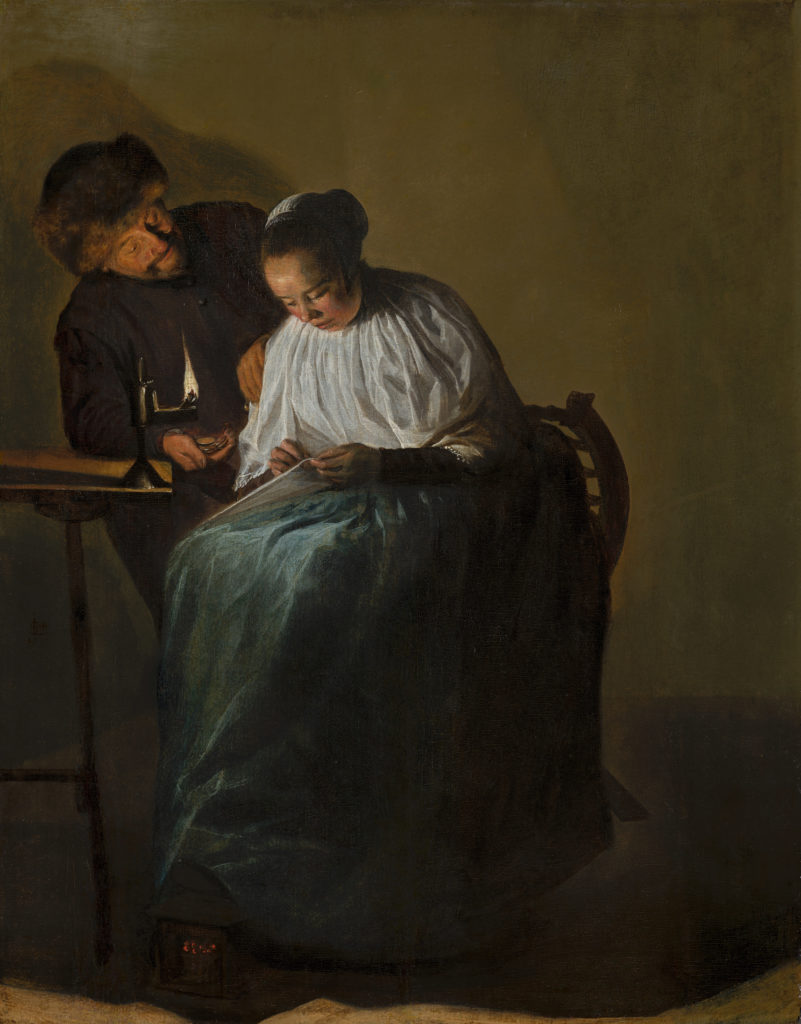
Only twenty works by her hand are known, mostly produced before Leyster’s marriage to Jan Miense Molenaer in 1636. It was the then deputy director of the Mauritshuis, Cornelis Hofstede de Groot, who published the first study of Leyster in 1893. Thanks to him, her monogram could be identified.
An Eye for Detail
The attractive works by Rachel Ruysch, Maria van Oosterwyck, and Judith Leyster are part of the permanent presentation in The Hague. But there appears to be something special about the painting by Clara Peeters in the Mauritshuis. Shortly after its acquisition, staff members of the Mauritshuis began to call the still life ‘Clara’ and ‘her’—as if the panel is a real person. The only other painting in the collection where we all speak of ‘her’ is Vermeer’s Girl with a Pearl Earring of circa 1665, one of the most celebrated and popular paintings in the entire museum.
A special feature of Still Life with Cheeses, Almonds and Pretzels is the meticulous detail in all elements of the composition, even including the stack of cheeses. The older cheese in front owes its greenish color to the parsley or horseradish juice that was added to the milk. Behind it is a larger cheese of the type known as Gouda. This cheese was cut right through the middle, exposing the hole made by the assay-master, who scooped out a bit and reinserted the rest after testing it. The round indentation on the top of the cheese is another sign of the hole he made. Atop the Gouda cheese lies a small sheep cheese, and on top of that a porcelain plate of butter curls. This surfeit of cheese was evidently not extravagant enough for Peeters, who surrounded the stack with costly objects, including a Chinese porcelain dish filled with dried figs, almonds and raisins. Next to the baardmankruik, a jug featuring a bearded head in relief, is an exceptional drinking vessel: a lidded façon de Venise glass partly filled with wine.
A True Pioneer
Peeters was a true pioneer. Her high-quality meal still lifes, in particular, seem to have been highly influential in the further development of this type of imagery in the Southern and Northern Netherlands. Actually, the purchase by the Mauritshuis provided the impetus for an exhibition, Slow Food: Still Lifes of the Golden Age, a show I curated in 2017. The idea for this exhibition on the genesis and development of the meal still life came from Anne Lenders, a young woman who was working in The Hague as junior curator at the time. As far as we know, Clara Peeters was one of the first female painters of independent still lifes in the Low Countries. Her earliest known painting, a meal still life, dates from 1607 (Fig. 5).
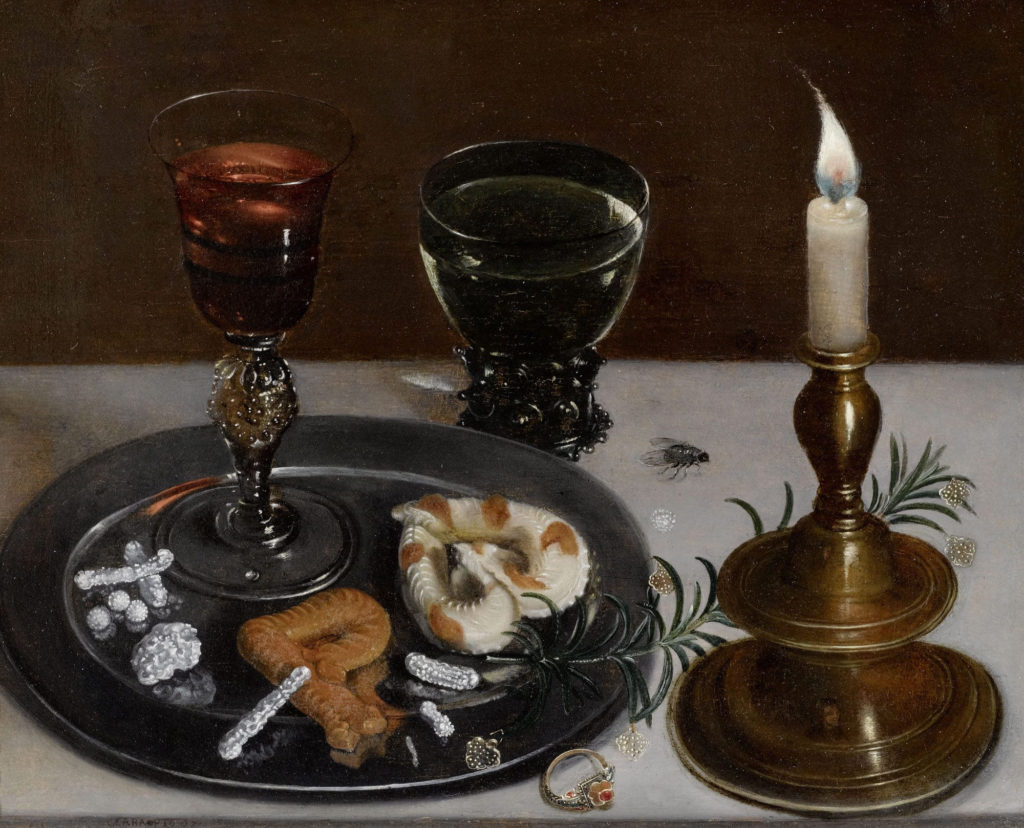
She must have been well-acquainted with the work of her contemporary Osias Beert (ca. 1580–1623), if we think of her meal still lifes of 1611 in the collection of the Museo Nacional del Prado in Madrid. As in Beert’s work, Peeters’s tabletop fills the picture and is depicted against a dark background. In her later work, however, Peeters began to fill her tables with more objects and foodstuffs than Beert did.
From Antwerp?
There are no documents about the life of Peeters, and we do not even know where she was born. It is highly likely that she worked in Antwerp or its immediate vicinity, as a number of her paintings bear the marks of Antwerp panel-makers and coppersmiths. Although women were free to enroll in the Antwerp painters’ guild from the beginning of the seventeenth century onwards, Peeters does not appear in the registers. She sometimes signed her works in full, in capital letters, but more often with her first name and last initial. Her latest dated work stems from 1621. Attempts to document her life have so far proved futile. All we know is she was active as a painter from about 1607 to 1622, most likely in Antwerp.
In Great Demand
Today we know some forty paintings by Clara Peeters, in which she depicted, amongst other motifs, flowers, fish and game. Her meal still lifes exerted a great deal of influence on other painters in the Low Countries. The Haarlem painter Pieter Claesz (1597/98–1660), who is known to have come from the vicinity of Antwerp, was clearly inspired by Peeters’s work. How would be have known her work? Her paintings, or copies after them, must have been in circulation early on. For instance, a copy of one of her still lifes was listed in 1627 in the estate of the painter Herman Saftleven the Elder, who lived in Rotterdam. Evidently Clara Peeters’s work was also known outside the Low Countries, as some of her still lifes were bought by Spanish collectors.
Peeters was very prolific, as suggested by the sometimes rather uneven quality of her work. Her paintings were in great demand, which might explain the existence of autograph replicas and variants. For example, the painting in the Mauritshuis exists in another version of such high quality that it must be the work of the artist herself (Fig. 6).
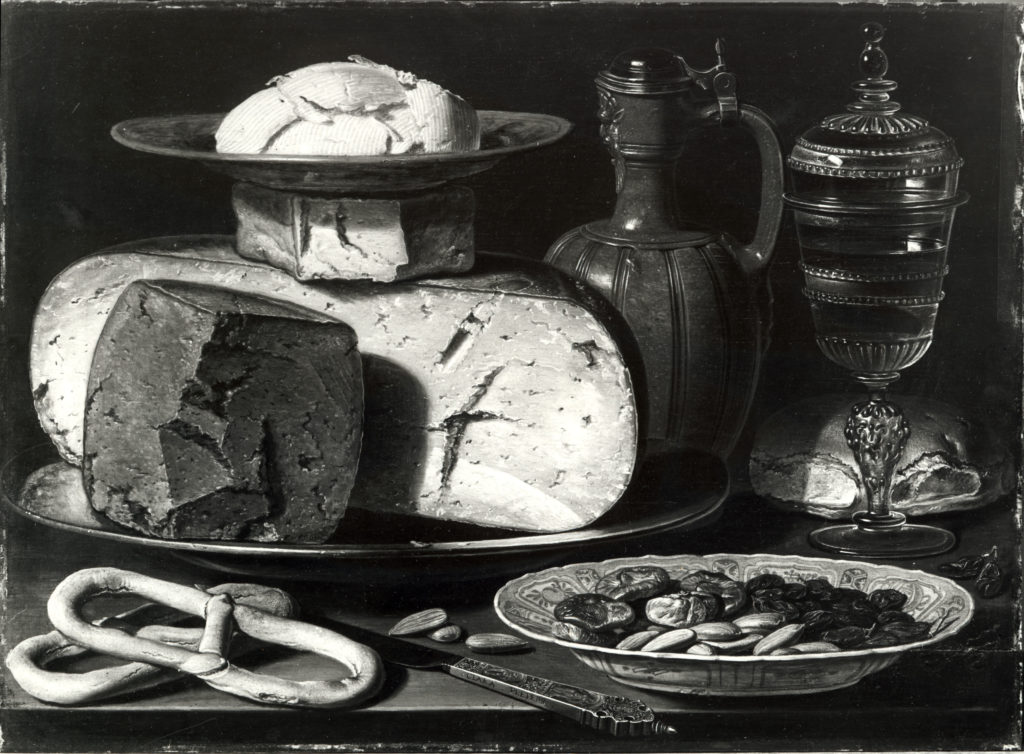
It was painted on a panel of almost identical dimensions and differs from the present painting only in minor details. The present location of this variant is unknown since 1934. The Mauritshuis panel was completely unknown in the art-historical literature until it surfaced in 1998 at a Paris auction. There it set a world record price for the artist.
Signed in Full
Clara Peeters included more than one reference to herself in the Mauritshuis painting. To begin with, her first and last name appear in full on the side of the elaborately decorated silver knife handle, in capitals (Fig. 7). She depicted this knife in a number of her paintings and it is most likely that she owned it. This knife contains many interesting details. The blade, for example, displays a characteristically hand-shaped Antwerp silver mark. This supports the theory that Peeters lived and worked in that city. She depicted this knife in at least five other paintings.

Below the two female figures engraved on the handle are the Latin words ‘FIDES’ (faith) and ‘TEMPO’, an abbreviation of ‘temperantia’ (temperance). They personify two of the seven virtues. Faith holds a cross and Temperance pours wine into a drinking cup. In the late sixteenth and early seventeenth century, such virtues as Faith, Hope, Charity, Temperance and Fortitude were frequently portrayed, mostly in the form of female personifications. The knife’s exhortation to temperance and faith must have been intended for its user, but perhaps also for the viewer contemplating this painting. In this specific instance, these two personifications must probably be seen in the context of marriage. In fact, the knife handle also displays a flaming heart depicted between two intertwined hands. This is a well-known symbol of conjugal love between husband and wife. It frequently appears in seventeenth-century pictorial culture as a gesture of troth and fidelity. In those days, elaborately decorated knives of this kind, engraved with the couple’s names, were given by the husband to his wife after the solemnization of their marriage. This raises the question of whether the knife Peeters depicted was given to her as a wedding present. Unfortunately, nothing is known about her life, and the marriage recorded on 31 May 1639 of one ‘Clara Peeters’ is presumably that of a woman of the same name.
Self-Portrait Included
Remarkably, Peeters also included a self-portrait in many of her paintings. Sometimes the likeness is no larger than five millimeters, as in the Mauritshuis painting. We can see a face framed by a white cap reflected in the metal lid of the earthenware jug (Fig. 8).

Peeters was one of the first, if not the first Northern artist to paint such self-portraits in a reflecting surface. Another painting depicting a woman seated at a table with precious objects is in all likelihood the artist’s self-portrait (Fig. 9).
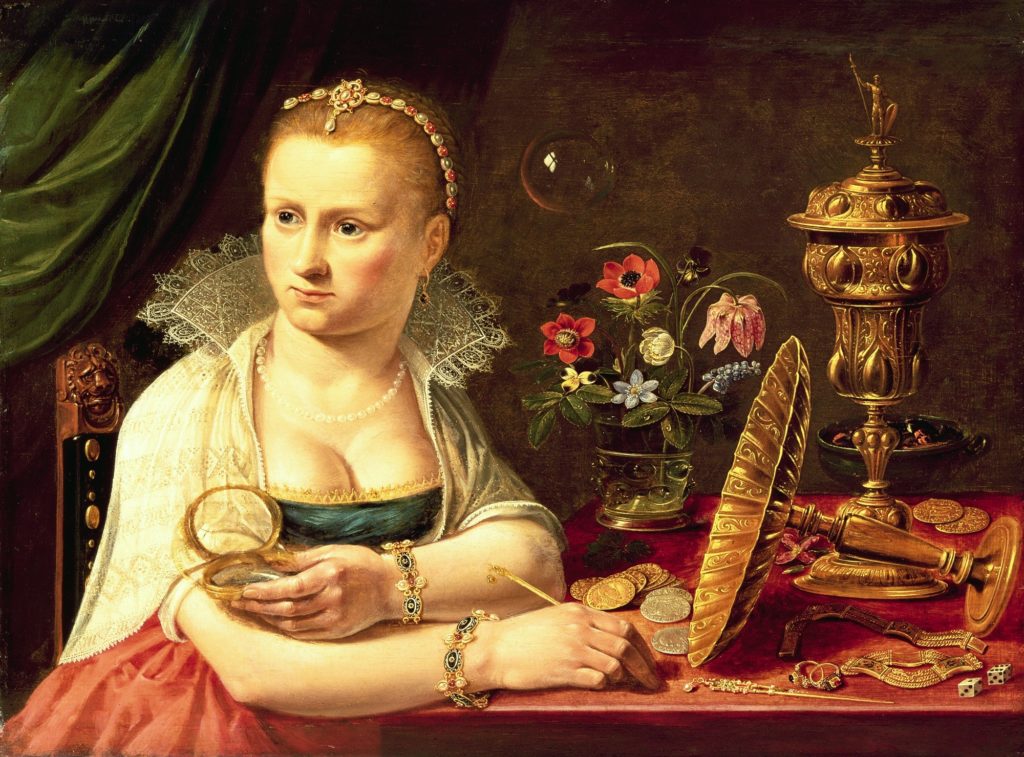
This work, datable to circa 1618, contains an ornate goblet at the far right that she painted seven years earlier, while the bouquet recalls her flower still lifes. Evidently Peeters included a bouquet in her self-portrait because she wished to be remembered as a painter of flower pieces as well. The painting provides slightly more insight into this still enigmatic artist. Now, more than four centuries later, it is time for Peeters’s many outstanding still lifes to take centre stage, as does the painting in the Mauritshuis.
Quentin Buvelot has been the Senior Curator of the Mauritshuis, The Hague, since 2008. He has authored many books and articles on seventeenth-century Dutch and Flemish painting, and has organized numerous exhibitions, including Slow Food (2017).
**
As of November 2020, Art Herstory offers two Clara Peeters note cards! Visit the shop for details. See also the Art Herstory Clara Peeters resource page.
Another Art Herstory blog post about a CODART Canon masterpiece:
Floral Still Life, 1726—A Masterpiece by Rachel Ruysch, by Dr. Lawrence W. Nichols
More Art Herstory blog posts to do with Dutch/Flemish women artists:
Dutch and Flemish Women Artists—A Major Exhibition at the National Museum of Women in the Arts, by Erika Gaffney
A Year for Dutch and Flemish Women Artists
Rachel Ruysch: The Art of Nature, by Stephanie Dickey
Rachel Ruysch’s Vase of Flowers with an Ear of Corn, by Lizzie Marx
Women and the Art of Flower Painting, by Ariane van Suchtelen
Anna Maria van Schurman: Brains, Arts and Feminist avant la lettre, by Maryse Dekker
Books, Blooms, Backer: The Life and Work of Catharina Backer, by Nina Reid
From a Project on Women Artists: The Calendar and the Cat Lady, by Lisa Kirch
Alida Withoos: Creator of beauty and of visual knowledge, by Catherine Powell
Levina Teerlinc, Illuminator at the Tudor Court, by Louisa Woodville
Women Artists of the Dutch Golden Age at the National Museum of Women in the Arts
Gesina ter Borch: Artist, not Amateur, by Nicole E. Cook
The Protofeminist Insects of Giovanna Garzoni and Maria Sibylla Merian, by Emma Steinkraus
Susanna Horenbout, Courtier and Artist, by Kathleen E. Kennedy



